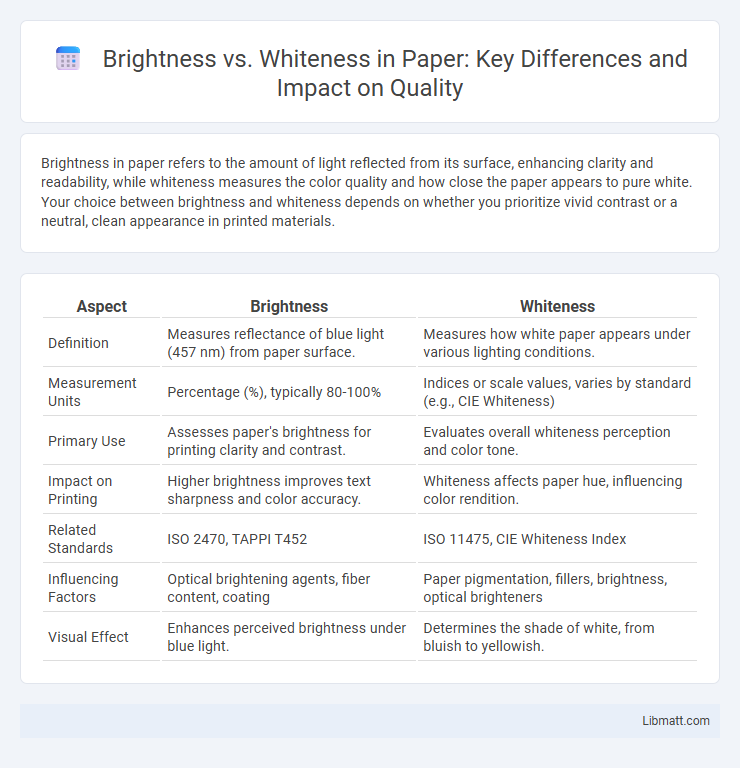Brightness in paper refers to the amount of light reflected from its surface, enhancing clarity and readability, while whiteness measures the color quality and how close the paper appears to pure white. Your choice between brightness and whiteness depends on whether you prioritize vivid contrast or a neutral, clean appearance in printed materials.
Table of Comparison
| Aspect | Brightness | Whiteness |
|---|---|---|
| Definition | Measures reflectance of blue light (457 nm) from paper surface. | Measures how white paper appears under various lighting conditions. |
| Measurement Units | Percentage (%), typically 80-100% | Indices or scale values, varies by standard (e.g., CIE Whiteness) |
| Primary Use | Assesses paper's brightness for printing clarity and contrast. | Evaluates overall whiteness perception and color tone. |
| Impact on Printing | Higher brightness improves text sharpness and color accuracy. | Whiteness affects paper hue, influencing color rendition. |
| Related Standards | ISO 2470, TAPPI T452 | ISO 11475, CIE Whiteness Index |
| Influencing Factors | Optical brightening agents, fiber content, coating | Paper pigmentation, fillers, brightness, optical brighteners |
| Visual Effect | Enhances perceived brightness under blue light. | Determines the shade of white, from bluish to yellowish. |
Understanding Brightness and Whiteness in Paper
Brightness in paper measures the reflectance of blue light, indicating how much light the paper reflects back to the viewer, which affects its perceived vividness. Whiteness assesses the overall color perception by considering reflectance across the visible spectrum, combining brightness with color hue to determine the paper's true white appearance. Understanding the difference helps you select paper that best suits printing needs, balancing vividness and color accuracy for optimal results.
Key Differences Between Brightness and Whiteness
Brightness measures the amount of light reflected from paper, indicating how much light the surface returns to the eye, while whiteness assesses how closely the paper's color approaches ideal white under specific lighting conditions. Brightness is quantified using ISO brightness standards or TAPPI brightness tests, reflecting short-wavelength light reflectance, whereas whiteness incorporates factors such as color tint and fluorescence to evaluate the paper's perceived purity and hue. Understanding these distinctions helps you select paper tailored for printing quality, ensuring accurate color reproduction and visual appeal.
How Brightness is Measured in Paper
Brightness in paper is measured using a standardized reflectance method that quantifies the amount of blue light reflected from the paper surface, typically at a wavelength of 457 nm. This metric, known as TAPPI brightness, evaluates the paper's ability to reflect short-wavelength blue light, distinguishing it from whiteness, which considers the overall color spectrum and includes other hues like yellow and red. Your understanding of paper brightness helps in selecting the right paper quality based on optical properties essential for printing and visual clarity.
Whiteness Scales and Standards Explained
Whiteness scales and standards quantify how white a paper appears by measuring the reflectance of light at specific wavelengths, primarily in the blue and ultraviolet spectrum. The most common standards include the ISO Brightness Scale, which assesses blue light reflectance to determine brightness, and the Hunter Whiteness Scale, which incorporates all visible wavelengths to evaluate true whiteness. Understanding these scales helps you select paper with the appropriate whiteness level for printing quality and visual clarity.
The Impact of Brightness on Print Quality
Brightness significantly affects print quality by enhancing the perceived sharpness and contrast of images on paper. Higher brightness levels in paper reflect more light, resulting in more vivid colors and clearer text, which improves overall readability and visual appeal. Choosing paper with optimal brightness ensures your printed materials achieve maximum clarity and professional presentation.
Whiteness and Its Influence on Color Reproduction
Whiteness in paper significantly influences color reproduction by affecting the perceived vibrancy and accuracy of printed colors. Higher whiteness levels enhance the reflectance of light across the visible spectrum, enabling more precise color matching and greater contrast in printed images. Optimal whiteness ensures that colors appear true to their original hues, improving overall print quality and visual appeal.
Paper Selection: Brightness vs. Whiteness for Printing Needs
Brightness in paper refers to the amount of blue-white light reflected, enhancing contrast and sharpness in printed documents, whereas whiteness measures the paper's overall lightness and color tone, influencing color accuracy and vibrancy. Selecting paper with higher brightness suits text-heavy prints for crisp readability, while higher whiteness is preferable for color-intensive applications requiring true-to-life hues. Optimal paper choice balances brightness and whiteness to meet specific printing demands, impacting final output quality and visual appeal.
Environmental Factors Affecting Paper Brightness and Whiteness
Environmental factors such as exposure to ultraviolet light, humidity, and air pollution significantly impact paper brightness and whiteness by causing photochemical degradation and yellowing. The presence of lignin and other impurities in paper fibers also intensifies sensitivity to environmental elements, accelerating color changes over time. You can preserve paper brightness and whiteness by storing it in controlled environments with low humidity, minimal light exposure, and clean air circulation.
Market Preferences: When to Choose Brightness or Whiteness
Market preferences for paper brightness and whiteness vary depending on the intended use and target audience. High brightness is preferred for documents requiring vivid contrast and sharp text clarity, enhancing readability for reports and textbooks. Whiteness is chosen when true color reproduction is crucial, such as in marketing materials and photo printing, ensuring your visuals appear vibrant and accurate.
Future Trends in Paper Brightness and Whiteness Technology
Future trends in paper brightness and whiteness technology emphasize the integration of advanced optical brightening agents (OBAs) with sustainable, eco-friendly raw materials to enhance visual performance while minimizing environmental impact. Innovations in nanotechnology and enzyme treatments enable more precise control of brightness levels and improved whiteness stability under varying light conditions. Research is increasingly directed towards developing biodegradable brightening compounds and smart paper products that adapt to ambient light, optimizing both aesthetic appeal and functional longevity.
Brightness vs whiteness (paper) Infographic

 libmatt.com
libmatt.com